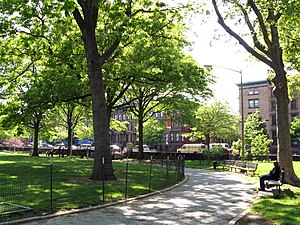Marcus Garvey Park
The Marcus Garvey Park , or Mount Morris Park , as he is called by the locals, is located in Harlem in the north of New York City's District Manhattan . It is maintained by the New York City Department of Parks and Recreation .
location
Marcus Garvey Park interrupts Fifth Avenue , which is diverted around the park via the park's western boundary - Mount Morris Park West. The park is bounded by 120th Street to the south and 124th Street to the north, and Madison Avenue to the east.
history
The social and political history of this place goes back to the early colonial times. Dutch settlers called it "Slangberg" (snake mountain) or Snake Hill because of the reptiles there. British forts watched over the Harlem River during the American Revolutionary War . The Common Council wanted to level this hilly area in order to build new roads, but local residents successfully petitioned the area demanding that it be kept as a public park. This over 8 hectare (20.2 acres) park became part of the Commissioners Plan of 1811 , which provided for a green space in north Manhattan beyond the road grid. The park was opened in 1840 and was originally called "Mount Morris Park". When a historic district was designated in this quarter, it was given the name of the park ("Mount Morris Park Historic District"), as the park is also part of this historic district.
In the summer of 1969, this park hosted the Harlem Cultural Festival , known as the "Black Woodstock" with a series of concerts. Today, the neighborhood initiative Marcus Garvey Park Alliance takes care of a variety of cultural events to promote major projects.
Mount Morris Park was renamed Marcus Garvey Park in 1973. The impetus for this renaming did not come from the neighborhood, but was politically initiated by Mayor John Lindsay and decided by the City Council of New York City. Marcus Garvey was a publisher, journalist, entrepreneur, black nationalism campaigner, and founder of the Universal Negro Improvement Association and African Communities League (UNIA-ACL). But even though "Marcus Garvey Park" has been on city maps for over 30 years, people in the neighborhood continue to refer to this green space as "Mount Morris Park".
Watchtower
Over time, the park was supplemented by various structural measures. A fire watchtower ( Harlem Fire Watchtower ) was designed by Julius Kroehl and erected in 1856. It is located in the middle of Marcus Garvey Park on an artificial plateau called "The Acropolis". This fire watchtower allowed a good overview of the area at this elevated point, in order to keep an eye out for fires in the time before the invention of the telephone - not least because at that time many houses were still made of wood and fires spread rapidly as a result threaten the whole city. There is still a 4.5-ton bell in the tower that was cast by Jones & Hitchcock to sound the alarm in the event of a fire. The 14 meter (47 foot) high cast iron tower is the only remaining of over eleven such towers built in New York City for this purpose and is now unique in the United States . In 1967 it was placed under monument protection.
Facilities
A remodel of Mount Morris Park in the 1930s added a community center and a children's health center. The park currently has the Pelham Fritz Recreation Center , named after a well-known park worker, and an amphitheater , both of which are located on the west side of the park at 122nd Street. A swimming pool was built on the north side of the park as well as two playgrounds for small children and children with disabilities, which were created in 1993. Major construction work was carried out in 2002, 2004 and 2005 to upgrade the entrance to the swimming pool and the park. There is a little league baseball field in the southwest corner of the park . In the southeast corner there is a dog run area covered with bark mulch .
See also
Individual evidence
- ↑ a b c d e f g Homepage New York City Department of Parks & Recreation . Retrieved January 9, 2011.

